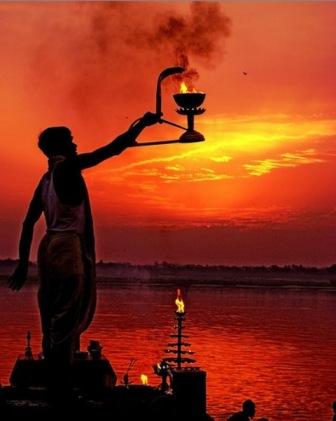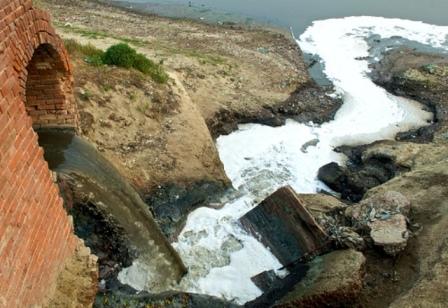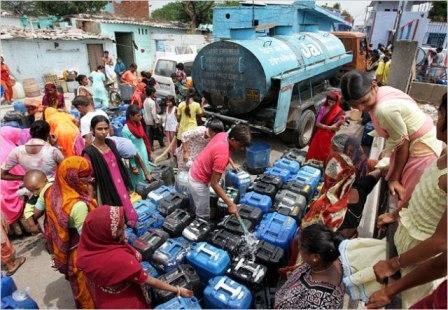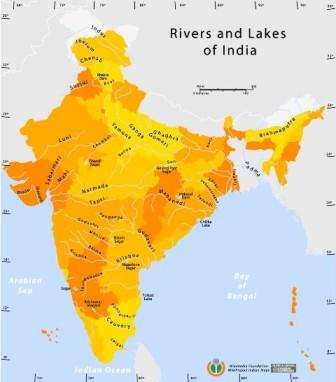The complete title reads as “The Pilgrim’s Progress from This World to That Which Is to Come”. I see the version two of this epic work by John Bunyan being written in our times, for the journey which the modern world has undertaken to achieve “development” at all costs. It won’t be an allegory this time. It would be a factual story of how we plundered the planet of its resources, to realize a life which could no longer be sustained within the replenishing levels of the natural processes.
William Pollard of the
Pilgrims making their way to the source of Ganges known as Gomukh (a glacier high up in the Himalayas named Gangotri). Photo Credit: Vineeta Rajput
There is a world which is to come, and it certainly does grow out of this world that we live in! For what we have been doing to our environment – land, water and air, this new world yet to come ain’t any difficult for us to picture. In India land, water, air and the numerous forces of nature have been worshipped as manifestations of one or the other God, from the hindu pantheon! Therein, lies the reason that religion, faith, environment, natural resources, infrastructure development, policy … all intersect and determine the outcome of issues ranging from managing its rivers to constructing a shipping canal across a strait. This very often creates situations which only befits the largest democracy in the world.

The Holy River: A priest worshipping river Ganga, in Haridwar, Uttarakhand. Photo Credit: Manoj_mannu

The Contaminated River: Sources of contamination and the major urban centers along the course of Ganga

Raw sewage discharging into Ganga at Kanpur (Photo Credit: Daniel Bacchuber)

Scene at a New Delhi Slum (Photo Credit: Ruth Fremson/The New York Times; More pictures here)
This isn’t intended to be a rant on India or the way decisions are made here. My focus is largely water and associated dynamics. I have been trying to picture our present world to understand how bad or how good our future world would be. All the commentaries, essays and pictures that I post are towards understanding the problems with our resources, in a manner that could benefit the people working in planning, management or conservation of these resources.
The rivers, it is said, have been the cradles of civilization. In India, it stands true of many rivers that have spawned massive centers like that of New Delhi and Kolkata. The anthropogenic impacts on these rivers have reached alarming levels. A lot many of the rivers cease to exist today and those which do exist have become seasonal in nature due to basin wide depletion of its water.

Photo Credit: Wikimedia Foundation
Here on, I plan to present case studies on the Rivers of India. There are seven major rivers and numerous other smaller ones of seasonal and perennial nature. (Source: National Institute of Hydrology) And there isn’t a place that could give a concise picture of the state of these rivers! Most of the information is either on paper and has not been digitized (as is the case in India) or has not been made public.
William Pollard of the Service Masters Company once said:
“Information is a source of learning. But unless it is organized, processed, and available to the right people in a format for decision making, it is a burden, not a benefit.”
At India Water Portal, we strive to turn this information burden into a benefit. The information availability on river systems and their basin wide utilization is very essential in understanding the water issues in India. And this information will be put up here in as much details as possible… a river at a time!
In a similar effort, although in a much a broader perspective, Ganesh Pangare, Vasudha Pangare and Binayak Das of World Water Institute (Pune, India) have reported extensively on India's water resources. Their book Springs of life: India's water resources can be read online at google books. In the overview of the book, they write:
"Springs of Life looks at water in all its complexities. An exhaustive account of water in India, the book documents the natural beauty of the water bodies, the ways in which communities live and interact with water, particularly in hostile ecosystems, the resilience of people living in water stressed regions and their common sense solution to local water problems."

Since I began this post by trying to imagine a world which is to come, United Nations's analysis of the situation predicts that armed struggles or "water wars" could be a possibility! The illustration below draws on the UN analysis.
/articles/need-case-study-and-concised-factual-information-rivers-india